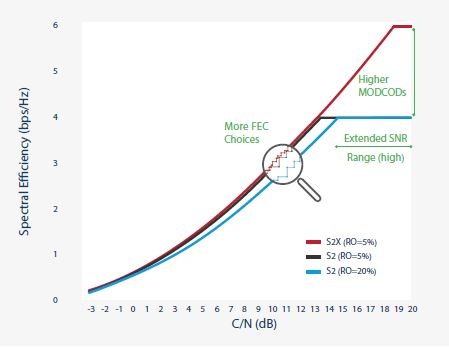How satellite operators and service providers leverage HTS and DVB-S2X technology will largely determine how they capitalize on growth opportunities. And as they plan their migration forward, they must consider what ground infrastructure capabilities will equip them with the greatest competitive advantage.
At iDirect, we believe there are five critical requirements for harnessing HTS and DVB-S2X to its fullest.
- Enabling higher capacity efficiencies
- Implementing intelligent terminals
- Scaling cost-effectively
- Enabling mainstream network integration
- Making HTS and DVB-S2X networks mobile
In a five-part blog series, we’ll explore these requirements and you can deploy today to gain an advantage in the market. So, here is the first consideration.
Enabling Higher Capacity Efficiencies for HTS/DVB-S2X Platforms
HTS, when combined with the right remote RF capabilities, delivers higher efficiencies and performance, effectively lowering the cost per bit of satellite capacity. The key to reaching the highest gains though, is to implement the highest possible MODCODs and saturate the wideband transponders — oftentimes with optimal carrier configurations.
The DVB-S2X standard defines higher modulations ranging up to 256APSK and standardized roll-off factors down from 20% to 5%. The right ground infrastructure platform should offer all these choices and provide full Adaptive Coding and Modulation (ACM) capabilities not just on the outbound, but also provide adaptivity on the inbound to harness the larger HTS transponders in the most efficient way.
With the introduction of UHTS, a platform must support even larger transponders (500 MHz) with highly efficient carrier configurations.
Another important measure of bandwidth performance is how well a platform can source and allocate satellite capacity across many spot beams. Look for a solution that can integrate any type of capacity into a global bandwidth pool, and then enables you to dynamically allocate bandwidth as needed to create tiered Service Level Agreements (SLAs). The ability to create highly flexible and customized service plans in a shared bandwidth pool will allow you to sell different services and monetize their capacity in the most effective way.
When DVB-S2X is implemented to its fullest, satellite operators can design next-generation architectures with features like beam hopping to adjust their payloads based on real-time demand on the ground. This capability will drive revolutionary efficiency gains in the years ahead. Intelligent payloads require the integration of ground and space infrastructures to measure and respond to demand.
So, when satellite operators are designing their next-generation payloads, they need a ground infrastructure partner that can support intelligent payloads on their platforms.
To learn more, visit IntelligentPathForward.com.
Take our poll:


3 thoughts on “The Path to Higher Performance: 5 Considerations for Implementing HTS and DVB-S2X to Your Advantage”
Comments are closed.